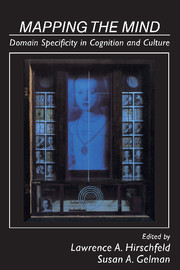Book contents
- Frontmatter
- Contents
- List of contributors
- Preface
- Part I Overview
- Part II The origins of domain knowledge: Biology and evolution
- Part III The origins of domain knowledge: Conceptual approaches
- 5 ToMM, ToBY, and Agency: Core architecture and domain specificity
- 6 Moral belief: Form versus content
- 7 Domain-specific knowledge and conceptual change
- 8 Is the acquisition of social categories based on domain-specific competence or on knowledge transfer?
- 9 The birth and nurturance of concepts by domains: The origins of concepts of living things
- Part IV Are domains theories?
- Part V Domains across cultures and languages
- Part VI Implications for education
- Author index
- Subject index
6 - Moral belief: Form versus content
Published online by Cambridge University Press: 04 August 2010
- Frontmatter
- Contents
- List of contributors
- Preface
- Part I Overview
- Part II The origins of domain knowledge: Biology and evolution
- Part III The origins of domain knowledge: Conceptual approaches
- 5 ToMM, ToBY, and Agency: Core architecture and domain specificity
- 6 Moral belief: Form versus content
- 7 Domain-specific knowledge and conceptual change
- 8 Is the acquisition of social categories based on domain-specific competence or on knowledge transfer?
- 9 The birth and nurturance of concepts by domains: The origins of concepts of living things
- Part IV Are domains theories?
- Part V Domains across cultures and languages
- Part VI Implications for education
- Author index
- Subject index
Summary
This is a two-part chapter, the first part of which attributes a moral domain to the infant and presents a model of the domain; and the second part of which shows how the primitives of the domain provide an invariant form in which to express the diverse moral beliefs of different cultures.
Part I: Infant's model
The subject matter of morality is social behavior, the relation among individuals, ultimately how one individual treats another. Human social competence is highly developed, and the ability to make moral judgments about social behavior is part of the competence. Some concepts of moral judgment are not unique, but are shared. For instance, the attribution of intention, which is central to morality, is a fundamental component of theory of mind (Leslie, 1987; Premack & Woodruff, 1978; Wellman, 1990; Wimmer & Perner, 1983), while aesthetics, which enters into moral judgment, is a hidden yet significant component of pedagogy (Premack, 1984, 1991). However, morality is not simply constructed from pieces of other social competences. Judgments concerning the “rightness” or “wrongness” of acts, an individual's “rights” and “responsibilities,” the concept of “ought,” are sui generis, and cannot be derived from concepts belonging to other parts of social competence.
What is the source of these distinctly moral concepts, of “right,” “wrong,” “ought,” “responsibility,” and the like? Are they irreducible primitives, or can we find their origin in other sources?
- Type
- Chapter
- Information
- Mapping the MindDomain Specificity in Cognition and Culture, pp. 149 - 168Publisher: Cambridge University PressPrint publication year: 1994
- 58
- Cited by



